|
THE DAY OF THE LORD
As the last millennium b.c.e. began, the appearance of the Sign of
the Cross was a harbinger of the Return. It was also then that a
temple to Yahweh in Jerusalem forever linked its sacred site to the
course of historic events and to Mankind’s messianic expectations.
The time and the place were no coincidence: the impending Return
dictated the enshrinement of the erstwhile Mission Control Center.
Compared to the mighty and conquering imperial powers of those
days—Babylonia, Assyria, Egypt—the Hebrew kingdom was a midget.
Compared to the greatness of their capitals—Babylon, Nineveh,
Thebes—with their sacred precincts, ziggurats, temples, processional
ways, ornate gates, majestic palaces, hanging gardens, sacred pools,
and river harbors—Jerusalem was a small city with hastily built walls
and an iffy water supply. And yet, millennia later, it is Jerusalem,
a living city, that is in our hearts and in the daily headlines,
while the grandeur of the other nations’ capitals has turned to dust
and crumbled ruins.
What made the difference? The Temple of Yahweh that was built in
Jerusalem, and its Prophets whose oracles came true. Their
prophecies, one therefore believes, still hold the key to the
Future.
The Hebrew association with Jerusalem, and in particular with Mount
Moriah, goes back to the time of Abraham. It was when he had
fulfilled his assignment of protecting the spaceport during the War
of the Kings that he was greeted by Malkizedek, the king of
Ir-Shalem ( Jerusalem), “who was a priest of the God Most High.”
There Abraham was blessed, and in turn took an oath, “by the God
Most High, possessor of Heaven and Earth.” It was again there, when
Abraham’s devotion was tested, that he was granted a Covenant with
God. Yet it took a millennium, until the right time and
circumstances, for the Temple to be built.
The Bible asserted that the Jerusalem temple was unique— and so
indeed it was: it was conceived to preserve the “Bond Heaven-Earth”
that the DUR.AN.KI of Sumer’s Nippur had once been.
And it came to pass
in the four hundred and eightieth year
after the Children of Israel came out of Egypt,
in the fourth year of Solomon’s reign,
in the second month,
that he began to build the House of the Lord.
Thus does the Bible record, in the first
Book of Kings (6:1), the memorable start of the construction of the
Temple of Yahweh in Jerusalem by King Solomon, giving us the exact
date of the event. It was a crucial, decisive step whose
consequences are still with us; and the time, it must be noted, was
when Babylon and Assyria adopted the Sign of the Cross as the
harbinger of the Return...
The dramatic story of the Jerusalem Temple starts not with Solomon
but with King David, Solomon’s father; and how he happened to become
Israel’s king is a tale that reveals a divine plan: to prepare for
the Future by resurrecting the Past.
David’s legacy (after a reign of 40 years) included a greatly
expanded realm, reaching in the north as far as Damascus (and
including the Landing Place!), many magnificent Psalms, and the
groundwork for Yahweh’s temple. Three divine emissaries played key
roles in the making of this king and his place in history; the Bible
lists them as “Samuel the Seer, Nathan the Prophet, and Gad the
Visionary.”
It was Samuel, the custodian-priest of the Ark of the
Covenant, who was instructed by God to “take the youth David, son of
Jesse, from herding sheep to be shepherd of Israel,” and Samuel
“took the oil-filled horn and anointed him to reign over Israel.”
The choosing of the young David, who was shepherding his father’s
flock, to be shepherd over Israel was doubly symbolic, for it harks
back to the golden age of Sumer. Its kings were called LU.GAL,
“Great Man,” but they strove to earn the cherished title EN.SI,
“Righteous Shepherd.” That, as we shall see, was only the beginning
of David’s and the Temple’s links to the Sumerian past.
David began his reign in Hebron, south of Jerusalem, and that, too,
was a choice filled with historic symbolism. The previous name of
Hebron, the bible repeatedly pointed out, was Kiryat Arba, “the
fortified city of Arba.” And who was Arba? “He was a Great Man of
the Anakim”—two biblical terms that render in Hebrew the Sumerian
LU.GAL and ANUNNAKI.
Starting with passages in the book of Numbers,
and then in Joshua, Judges, and Chronicles, the Bible reported that
Hebron was a center of the descendants of the “Anakim, who as the Nefilim are counted,” thus connecting them to the Nefilim of Genesis
6 who intermarried with the Daughters of Adam. Hebron was still
inhabited at the time of the Exodus by three sons of Arba, and it
was Caleb the son of Jephoneh who captured the city and slew them in
behalf of Joshua.
By choosing to be king in Hebron, David
established his kingship as a direct continuation of kings linked to
the Anunnaki of Sumerian lore.
He reigned in Hebron for seven years, and then moved his capital to
Jerusalem. His seat of kingship—the “City of David”—was built on
Mount Zion, just south of and separated by a small valley from Mount
Moriah (where the platform built by the Anunnaki was, Fig. 83). He
constructed the Miloh, the Filling, to close the gap between the two
mounts, as a first step to building, on the platform, Yahweh’s
temple; but all he was allowed to erect on Mount Moriah was an
altar. God’s word, through the Prophet Nathan, was that because
David had shed blood in his many wars, not he but his son Solomon
would build the temple.
Devastated by the prophet’s message, David went and “sat before
Yahweh,” in front of the Ark of the Covenant (which was still housed
in a portable tent).
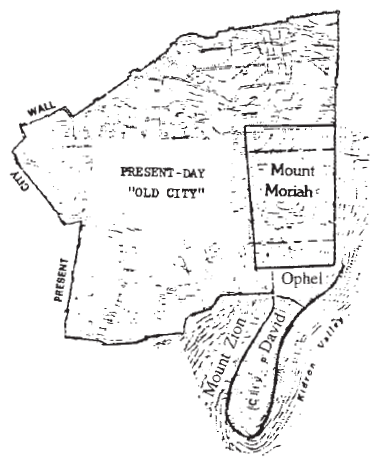
Figure 83
Accepting God’s decision, he
asked for one reward for his devout loyalty to Him: an assurance, a
sign, that it would indeed be the House of David that would build
the Temple and be forever blessed. That very night, sitting in front
of the Ark of the Covenant by which Moses had communicated with the
Lord, he received a divine sign: he was given a Tavnit—a scale
model—of the future temple!
One can shrug off the tale’s veracity were it not for the fact that
what happened that night to King David and his temple project was
the equivalent of the Twilight Zone tale of the Sumerian king Gudea,
who more than a thousand years earlier was likewise given in a
vision-dream a tablet with the architectural plan and a brick mold
for the construction of a temple in Lagash for the god Ninurta.
When he neared the end of his days, King David summoned to Jerusalem
all the leaders of Israel, including the tribal chiefs and the
military commanders, the priests and the royal office holders, and
told them of Yahweh’s promise; and in full view of those gathered he
handed to his son Solomon,
“the Tavnit of the temple and all its
parts and chambers... the Tavnit that he received by the Spirit.”
There was more, for David also handed over to Solomon,
“all that
Yahweh, in His own hand written, gave to me for understanding the
workings of the Tavnit”: A set of accompanying instructions,
divinely written.
(I Chronicles, Chapter 28).
The Hebrew term Tavnit is translated in the King James English Bible
“pattern” but is rendered “plan” in more recent translations,
suggesting that David was given some kind of an architectural
drawing. But the Hebrew word for “plan” is Tokhnit. Tavnit, on the
other hand, is derived from the root verb that means “to construct,
to build, to erect,” so what David was given and what he handed over
to his son Solomon was a “constructed model”—in today’s parlance, a
scale model. (Archaeological finds throughout the ancient Near East
have indeed unearthed scale models of chariots, wagons, ships,
workshops, and even multilevel shrines.)
The biblical books of Kings and Chronicles provide precise
measurements and clear structural details of the Temple and its
architectural designs. Its axis ran east–west, making it an “eternal
temple” aligned to the equinox. Consisting of three parts (see Fig.
64), it adopted the Sumerian temple plans of a forepart (Ulam in
Hebrew), a great central hall (Hekhal in Hebrew, stemming from the
Sumerian E.GAL, “Large Abode”), and a Holy of Holies for the Ark of
the Covenant. That innermost section was called the Dvir (the
“Speaker”)—for it was by means of the Ark of the Covenant that God
spoke to Moses.
As in Sumerian ziggurats, which traditionally were built to express
the sexagesimal’s “base sixty” concept, the Temple of Solomon also
adopted sixty in its construction: the main section (the Hall) was
60 cubits (about 100 feet) in length, 20 cubits (60:3) wide, and 120
(60 × 2) cubits in height. The Holy of Holies was 20 by 20
cubits—just enough to hold the Ark of the Covenant with the two
golden Cherubim atop it (“their wings touching”).
Tradition, textual
evidence, and archaeological research indicate that the Ark was
placed precisely on the extraordinary rock on which Abraham was
ready to sacrifice his son Isaac; its Hebrew designation, Even Shatiyah, means “Foundation Stone,” and Jewish legends hold that it
is from it that the world will be re-created.
Nowadays it is covered
over and surrounded by the Dome of the Rock (Fig. 84). (Readers can
find more about the sacred rock and its enigmatic cave and secret
subterranean passages in The Earth Chronicles Expeditions.)
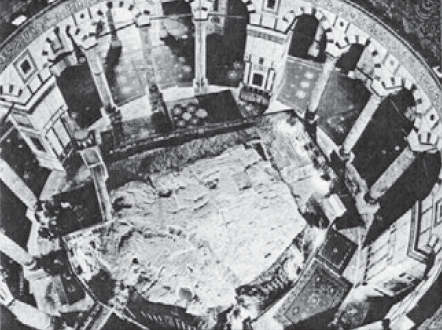
Figure 84
Though these were not monumental measurements compared to the
skyscraping ziggurats, the Temple, when completed, was truly
magnificent; it was also unlike any other contemporary temple in
that part of the world. No iron or iron tools were used for its
erection upon the platform (and absolutely none in its operation—all
the utensils were of copper or bronze), and the building was inlaid
inside with gold; even the nails holding the golden plates in place
were made of gold.
The quantities of gold used ( just “for the Holy
of
Holies, 600 talents; for the nails, fifty shekels”) were enormous—so
much so that Solomon arranged for special ships to bring gold from
Ophir (believed to be in southeast Africa).
The Bible offers no explanation, neither for the prohibition against
using anything made of iron on the site nor for the inlaying of
everything inside the temple with gold. One can only speculate that
iron was shunned because of its magnetic properties, and gold
because it is the best electrical conductor.
It is significant that the only two other known instances of shrines
so inlaid with gold are on the other side of the world. One is the
great temple in Cuzco, the Inca capital in Peru, where the great god
of South America, Viracocha, was worshipped. It was called the
Coricancha (“Golden Enclosure”), for its Holy of Holies was
completely inlaid with gold.
The other is in Puma-Punku on the
shores of Lake Titicaca in Bolivia, near the famed ruins of
Tiwanaku. The ruins there consist of the remains of four chamberlike
stone buildings whose walls, floors, and ceilings were each cut out
of a single colossal stone block. The four enclosures were
completely inlaid inside with golden plates that were held in place
with golden nails. Describing the sites (and how they were looted by
the Spaniards) in
The Lost Realms, I have suggested that Puma-Punku
was erected for the stay of Anu and Antu when they visited Earth
circa 4000 b.c.e.
According to the Bible, tens of thousands of workmen were needed for
seven years for the immense undertaking. What, then, was the purpose
of this House of the Lord? When all was ready, with much pomp and
circumstance, the Ark of the Covenant was carried by priests and
placed in the Holy of Holies.
As soon as the Ark was put down and
the curtains separating the Holy of Holies from the great hall were
drawn,
“the House of the Lord was filled with a cloud and the
priests could not remain standing.”
Then Solomon offered a
thanksgiving prayer, saying:
Lord who has chosen to dwell in the cloud: I have built for Thee a
stately House,
a place where you may dwell forever...
Though the uttermost heavens cannot contain Thee,
May you hear our supplications from Thine seat
in heaven.
“And Yahweh appeared to Solomon that night, and said to him: I have
heard your prayer; I have chosen this site for my house of worship... From heaven I will hear the prayers of my people and forgive
their transgressions... Now I have chosen and consecrated this
House for my Shem to remain there forever”
(II Chronicles, Chapters
6–7)
The word Shem—here and earlier, as in the opening verses of chapter
6 of Genesis—is commonly translated “Name.”
As far back as in my
first book,
The Twelfth Planet, I have suggested that the term
originally and in the relevant context referred to what the
Egyptians called the “Celestial Boat” and the Sumerians called
MU—“sky ship”—of the gods. Accordingly, the Temple in Jerusalem,
built atop the stone platform, with the Ark of the Covenant placed
upon the sacred rock, was to serve as an earthly bond with the
celestial deity—both for communicating and for the landing of his
sky ship!
Throughout the Temple there was no statue, no idol, no graven image.
The only object within it was the hallowed Ark of the Covenant—and
“there was nothing in the Ark except the two tablets that were given
to Moses in Sinai.”
Unlike the Mesopotamian ziggurat temples, from Enlil’s in Nippur to
Marduk’s in Babylon, this one was not a place of residence for the
deity, where the god lived, ate, slept, and bathed. It was a House
of Worship, a place of divine contact; it was a temple for a Divine
Presence by the Dweller in the Clouds.
It is said that a picture is worth a thousand words; it is certainly
true where there are few pertinent words but many relevant pictures.
It was about the time that the Jerusalem temple was completed and
consecrated to the Dweller in the Clouds that a noticeable change in
the sacred glyptic—the depiction of the divine—took place where such
depictions were common and permissible, and (at the time) first and
foremost in Assyria. They showed, most clearly, the god Ashur as a
“dweller of the clouds,” full face or with just his hand showing,
frequently depicted holding a bow (Fig. 85)—a depiction reminding
one of the Bible’s tale of the Bow in the Cloud that was a divine
sign in the aftermath of the Deluge.
A century or so later, Assyrian depictions introduced a new variant
of the God in the Cloud. Classified as “Deity in a Winged Disc,”
they clearly showed a deity inside the emblem of the Winged Disc, by
itself (Fig. 86a) or as it joins the Earth (seven dots) and the Moon
(crescent) (Fig. 86b). Since the Winged Disc represented Nibiru, it
had to be a deity arriving with Nibiru.
Clearly, then, these
depictions implied expectations of the nearing arrival not only of
the planet, but also of its divine dwellers, probably led by Anu
himself.
The changes in glyphs and symbols, begun with the Sign of the Cross,
were manifestations of more profound expectations, of overwhelming
changes and wider preparations called for by the expected Return.
However, the expectations and preparations were not the same in
Babylon as in Assyria.
In one, the messianic expectations were
centered on the god(s) who were already there; in the other, the
expectations related to the god(s) about to return and reappear.
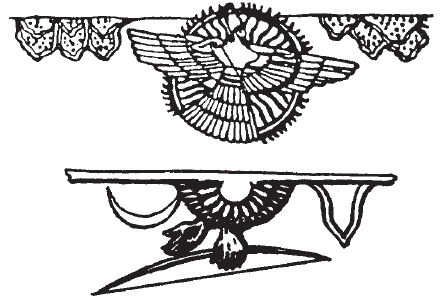
Figure 85
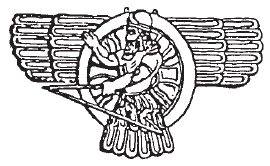
Figure 86a
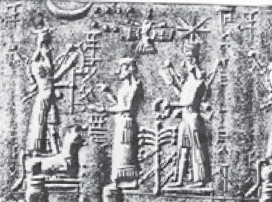
Figure 86b
In Babylon the expectations were mostly religious—a messianic
revival by Marduk through his son Nabu. Great efforts were
undertaken to resume, circa 960 b.c.e., the sacred Akitu ceremonies
in which the revised Enuma elish— appropriating to Marduk the
creation of Earth, the reshaping of the Heavens (the Solar System),
and the fashioning of Man—was publicly read.
The arrival of Nabu
from his shrine in Borsippa ( just south of Babylon) to play a
crucial role in the ceremonies was an essential part of the revival.
Accordingly, the Babylonian kings who reigned between 900 b.c.e. and
730 b.c.e. resumed bearing Marduk-related names and, in great
numbers, Nabu-related names.
The changes in Assyria were more geopolitical; historians consider
the time—circa 960 b.c.e.—as the start of the NeoAssyrian Imperial
period. In addition to inscriptions on monuments and palace walls,
the main source of information about Assyria in those days is the
annals of its kings, in which they recorded what they did, year by
year. Judging by that, their main occupation was Conquest. With
unparalleled ferocity, its kings set out on one military campaign
after another not only to have dominion over the olden Sumer &
Akkad, but also over what they deemed essential for the Return:
Control of the space-related sites.
That this was the purpose of the campaigns is evident not only from
their targets, but also from the grand stone reliefs on the walls of
Assyrian palaces from the ninth and eighth centuries b.c.e. (which
one can see in some of the world’s leading museums): as on some
cylinder seals, they show the king and the high priest, accompanied
by winged Cherubim—Anunnaki “astronauts”—flanking the Tree of Life
as they welcome the coming of the god in the Winged Disc (Fig.
87a,b).
A divine arrival was clearly expected!
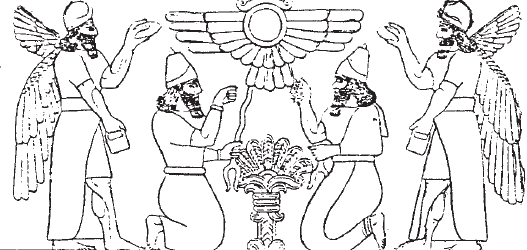
Figure 87a
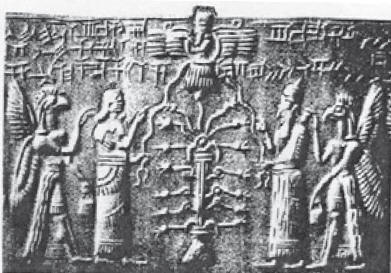
Figure 87b
Historians connect the start of this Neo-Assyrian period to the
establishment of a new royal dynasty in Assyria, when
Tiglath-Pileser II ascended the throne in Nineveh. The pattern of
aggrandizement at home and conquest, destruction, and annexation
abroad was set by that king’s son and grandson,
who followed him as kings of Assyria. Interestingly, their first
target was the area of the Khabur River, with its important trade
and religious center—Harran.
Their successors took it from there.
Frequently bearing the same
name as previous glorified kings (hence the numerations I, II, III,
etc. for them), the successive kings expanded Assyrian control in
all directions, but with special emphasis on the coastal cities and
mountains of La-ba-an (Lebanon). Circa 860 b.c.e. Ashurnasirpal
II—who wore the cross symbol on his chest (see Fig. 76)—boasted of
capturing the Phoenician coastal cities of Tyre, Sidon, and Gebal
(Byblos), and of ascending the Cedar Mountain with its sacred site,
the olden Landing Place of the Anunnaki.
His son and successor Shalmaneser III recorded the erecting there of
a commemorative stela calling the place Bit Adini. The name
literally meant “the Eden Abode”—and was known by that same name to
the biblical Prophets. The Prophet Ezekiel castigated the king of
Tyre for deeming himself a god because he had been to that sacred
place and “moved within its fiery stones”; and the Prophet Amos
listed it when he spoke of the coming Day of the Lord.
As could be expected, the Assyrians then turned their attention to
the other space-related site. After the death of Solomon his kingdom
was split by his contending heirs into “Judea” (with Jerusalem as
capital) in the south and “Israel” and its ten tribes in the north.
In his best-known inscribed monument, the Black Obelisk, Shalmaneser
III recorded the receipt of tribute from the Israelite king Jehu
and, in a scene dominated by the Winged Disc emblem of Nibiru,
depicted him kneeling in obeisance (Fig. 88).

Figure 88
Both the Bible and the
Assyrian annals recorded the subsequent invasion of Israel by Tiglath-Pileser III (744–727 b.c.e.), the detaching of its better
provinces, and the partial exile of its leaders.
Then, in 722 b.c.e., his son Shalmaneser V overran what was left of Israel,
exiled all of its people, and replaced them with foreigners; the Ten
Tribes were gone, their whereabouts remaining a lasting mystery.
(Why and how, on his return from Israel, Shalmaneser was punished
and abruptly replaced on the throne by another son of
Tiglath-Pileser is also an unsolved mystery.)
Having already captured the Landing Place, the Assyrians were now at
the doorstep of the final prize, Jerusalem; but again they held off
the final assault. The Bible explained it by attributing it all to
the will of Yahweh; an examination of
Assyrian records suggests that what and when they did in Israel and
Judea was synchronized with what and when they did about Babylon and
Marduk.
After the capture of the space-related site in Lebanon— but before
launching the campaigns toward Jerusalem—the Assyrians took an
unprecedented step for reconciliation with Marduk. In 729 b.c.e.
Tiglath-Pileser III entered Babylon, went to its sacred precinct,
and “took the hands of Marduk.” It was a gesture with great
religious and diplomatic significance; the priests of Marduk
approved the reconciliation by inviting Tiglath-Pileser to share in
the god’s sacramental meal.
Following that, Tiglath-Pileser’s son
Sargon II marched southward into the olden Sumer & Akkad areas, and
after seizing Nippur turned back to enter Babylon. In 710 b.c.e. he,
like his father, “took the hands of Marduk” during the New Year
ceremonies.
The task of capturing the remaining space-related site fell to
Sargon’s successor, Sennacherib. The assault on Jerusalem in 704
b.c.e., at the time of its King Hezekiah, is amply recorded both in
Sennacherib’s annals and in the Bible. But while Sennacherib in his
inscriptions spoke just of the successful seizing of Judean
provincial cities, the Bible provides a detailed tale of the siege
of Jerusalem by a mighty Assyrian army that was miraculously wiped
out by Yahweh’s will.
Encircling Jerusalem and entrapping its people, the Assyrians
engaged in psychological warfare by shouting discouraging words to
the defenders on the city’s walls, ending with vilification of
Yahweh. The shocked king, Hezekiah, tore his clothes in mourning and
prayed in the Temple to “Yahweh, the God of Israel, who rests upon
the Cherubim, the sole God upon all the nations,” for help.
In
response, the Prophet Isaiah conveyed to him God’s oracle: the
Assyrian king shall never enter the city, he will return home in
failure, and there he will be assassinated.
And it came to pass that night
that the Angel of Yahweh went forth
and smote in the camp of the Assyrians
a hundred and eighty-five thousand.
And at sunrise, lo and behold,
they were all dead corpses.
So Sennacherib, the king of Assyria, departed
and journeyed back to his abode in Nineveh
2 Kings 19: 35–36
To make sure the reader realizes that the whole prophecy came true,
the biblical narrative then continues:
“And Sennacherib went away,
and journeyed back to Nineveh; and it was when he was bowing down in
his temple to his god... that Adramelekh and Sharezzer struck him
down with a sword, and they fled to the land of Ararat. His son
Esarhaddon became king in his stead.”
The biblical postscript is an amazingly informed record: Sennacherib
was indeed murdered, by his own sons, in 681
b.c.e. For the second time, Assyrian kings who attacked Israel or
Judea were dead as soon as they went back.
While prophecy—the foretelling of what is yet to happen—is
inherently what is expected of a prophet, the Prophets of the Hebrew
Bible were more than that. From the very beginning, as was made
clear in Leviticus, a prophet was not to be “a magician, a wizard,
an enchanter, a charmer or seer of spirits, a fortune-teller, or one
who conjures the dead”—a pretty comprehensive list of the varied
fortune-tellers of the surrounding nations. Their mission as
Nabih—“Spokesmen”—was to convey to kings and peoples Yahweh’s own
words.
And as Hezekiah’s prayer made clear, while the
Children of
Israel were His Chosen People, he was “sole God upon all the
nations.”
The Bible speaks of prophets from Moses on, but only fifteen of them
have their own books in the Bible. They include the three
“majors”—Isaiah, Jeremiah, and Ezekiel— and twelve “minors.” Their
prophetic period began with Amos in Judea (circa 760 b.c.e.) and
Hoseah in Israel (750 b.c.e.) and ended with Malachi (circa 450
b.c.e.). As expectations of the Return took shape, geopolitics,
religion, and actual happenings combined to serve as the foundation
of biblical Prophecy.
The biblical Prophets served as Keepers of the Faith and were the
moral and ethical compass of their own kings and people; they were
also observers and predictors on the world arena by possessing
uncannily accurate knowledge of goings-on in distant lands, of court
intrigues in foreign capitals, of which gods were worshipped where,
plus amazing knowledge of history, geography, trade routes, and
military campaigns. They then combined such awareness of the Present
with knowledge of the Past to foretell the Future.
To the Hebrew Prophets,
Yahveh was not only El Elyon— “God
Supreme”—and not only God of the gods, El Elohim, but a Universal
God—of all nations, of the whole Earth, of the universe. Though His
abode was in the Heaven of Heavens, He cared for his creation—Earth
and its people. Everything that has happened was by His will, and
His will was carried out by Emissaries—be it Angels, be it a king,
be it a nation.
Adopting the Sumerian distinction between
predetermined Destiny and free-willed Fate, the Prophets believed
that the Future could be foretold because it was all pre-planned,
yet on the way thereto, things could change. Assyria, for example,
was at times called God’s “rod of wrath” with which other nations
were punished, but when it chose to act unnecessarily brutally or
out of bounds, Assyria itself was in turn subjected to punishment.
The Prophets seemed to be delivering a two-track message not only in
regard to current events, but also in respect to the Future. Isaiah,
for example, prophesied that Mankind should expect a Day of Wrath
when all the nations (Israel included) shall be judged and
punished—as well as look forward to an idyllic time when the wolf
shall dwell with the lamb, men shall beat their swords into
plowshares, and Zion shall be a light unto all nations.
The contradiction has baffled generations of biblical scholars and
theologians, but a close examination of the Prophets’ words leads us
to an astounding finding: the Day of Judgment was spoken of as the
Day of the Lord; the messianic time was expected at the End of Days;
and the two were neither synonymous nor predicted as concurrent
events.
They were two separate events, due to occur at different
times:
One, the Day of the Lord, a day of God’s judgment, was about to
happen;
The other, ushering a benevolent era, was yet to come, sometime in
the future.
Did the words spoken in Jerusalem echo the debates in Nineveh and
Babylon regarding which time cycle applies to the future of gods and
men—Nibiru’s orbital Divine Time or the zodiacal Celestial Time?
Undoubtedly, as the eighth century b.c.e. was ending, it was clear
in all three capitals that the two time cycles were not identical;
and in Jerusalem, speaking of the coming Day of the Lord, the
biblical prophets in fact spoke of the Return of Nibiru.
Ever since it rendered in the opening chapter of Genesis an
abbreviated version of the Sumerian Epic of Creation, the Bible
recognized the existence of Nibiru and its periodic return to
Earth’s vicinity, and treated it as another—in this case,
celestial—manifestation of Yahweh as a Universal God. The Psalms and
the Book of Job spoke of the unseen Celestial Lord that “in the
heights of heaven marked out a circuit.”
They recalled this
Celestial Lord’s first appearance—when he collided with Tiamat
(called in the Bible Tehom and nicknamed Rahab or Rabah, the Haughty
One), smote her, created the heavens and “the Hammered Bracelet”
(the Asteroid Belt), and “suspended the Earth in the void”; they
also recalled the time when that celestial Lord caused the Deluge.
The arrival of Nibiru and the celestial collision, leading to
Nibiru’s great orbital circuit, were celebrated in the majestic
Psalm 19:
The heavens bespeak the glory of the Lord;
The Hammered Bracelet proclaims his handiwork...
He comes forth as a groom from the canopy;
Like an athlete he rejoices to run the course.
From the end of the heavens he emanates,
and his circuit is to their end.
It was the nearing of the Celestial Lord at the time of the Deluge
that was held to be the forerunner of what will happen next time the
celestial Lord will return (Psalm 77: 6, 17–19):
I shall recall the Lord’s deeds,
remember thine
wonders in antiquity...
The waters saw thee, O Lord, and shuddered.
Thine splitting sparks went forth,
lightnings lit up the world.
The sound of thine thunder was rolling,
the Earth was agitated and it quaked.
The Prophets considered those earlier phenomena as the guide for
what to expect. They expected the Day of the Lord (to quote the
Prophet Joel) to be a day when,
“the Earth shall be agitated, Sun and
Moon shall be darkened, and the stars shall withhold their shining... A day that is great and terrifying.”
The Prophets brought the word of Yahweh to Israel and all nations
over a period of about three centuries. The earliest of the fifteen
Literary Prophets was Amos; he began to be God’s spokesman (“Nabih”)
circa 760 b.c.e. His prophecies covered three periods or phases: he
predicted the Assyrian assaults in the near future, a coming Day of
Judgment, and an Endtime of peace and plenty.
Speaking in the name
of,
“the Lord Yahweh who reveals His secrets to the Prophets,” he
described the Day of the Lord as a day when “the Sun shall set at
noon and the Earth shall darken in the midst of daytime.”
Addressing
those who worship the “planets and star of their gods,” he compared
the coming Day to the events of the Deluge, when “the day darkened
as night, and the waters of the seas poured upon the earth;” and he
warned those worshippers with a rhetorical question (Amos 5: 18):
Woe unto you that desire the Day of the Lord!
To what end is it for you?
For the day of the Lord is darkness and no light.
A half-century later, the Prophet Isaiah linked the prophecies of
the “Day of the Lord” to a specific geographical site, to the “Mount
of the Appointed Time,” the place “on the northern slopes,” and had
this to say to the king who had set himself up on it:
“Behold, the
Day of the Lord cometh with pitiless fury and wrath, to lay the
earth desolate and destroy the sinners upon it.”
He, too, compared
what is about to happen to the Deluge, recalling the time when the
“Lord came as a destroying tempest of mighty waves,” and described
(Isaiah 13: 10,13) the coming Day as a celestial occurrence that
will affect the Earth:
The stars of heaven and its constellations
shall not give their light;
the Sun shall be darkened at its rising
and the Moon shall not shine its light...
The heavens shall be agitated
and the Earth in its place will be shaken;
When the Lord of Hosts shall be crossing
on the day of his wrath.
Most noticeable in this prophecy is the identification of the Day of
the Lord as the time when “the Lord of Hosts”— the celestial, the
planetary lord—“shall be crossing.”
This is the very language used
in Enuma elish when it describes how the invader that battled Tiamat
came to be called NIBIRU:
“Crossing shall be its name!”
Following Isaiah, the Prophet Hosea also foresaw the Day of the Lord
as a day when Heaven and Earth shall “respond” to each other—a day
of celestial phenomena resonating on Earth.
As we continue to examine the prophecies chronologically, we find
that in the seventh century b.c.e. the prophetic pronouncements
became more urgent and more explicit:
the Day of the Lord shall be a
Day of Judgment upon the nations, Israel included, but primarily
upon Assyria for what it has done and upon Babylon for what it will
do, and the Day is approaching, it is near—
The great Day of the Lord is approaching— It is near!
The sound of the Lord’s Day hasteth greatly.
A day of wrath is that
day, a day of trouble and distress,
a day of calamity and
desolation,
a day of darkness and deep gloom,
a day of clouds and
thick mist.
Zephania, 1: 14–15
Just before 600 b.c.e. the Prophet Habakkuk prayed to the “God who
in the nearing years is coming,” and who shall show mercy in spite
of His wrath. Habakkuk described the expected celestial Lord as a
radiant planet—the very manner in which Nibiru was depicted in Sumer
& Akkad. It shall appear, the Prophet said, from the southern skies:
The Lord from the south shall come...
Covered are the heavens
with his halo,
His splendor fills the Earth.
His rays shine forth
from where his power is concealed.
The Word goes before him, sparks
emanate from below.
He pauses to measure the Earth;
He is seen, and
the nations tremble.
Habakkuk 3: 3–6
The prophecies’ urgency increased as the sixth century
b.c.e. began.
“The Day of the Lord is at hand!” the Prophet Joel
announced;
“The Day of the Lord is near!” the Prophet Obadiah
declared.
Circa 570 b.c.e. the Prophet Ezekiel was given the
following urgent divine message (Ezekiel 30: 2–3):
Son of Man, prophesy and say:
Thus sayeth the Lord God: Howl and
bewail for the Day! For the Day is near— the Day of the Lord is
near!
Ezekiel was then away from Jerusalem, having been taken into exile
with other Judean leaders by the Babylonian king Nebuchadnezzar. The
place of exile, where Ezekiel’s prophecies and famed vision of the
Celestial Chariot took place, was on the banks of the Khabur River,
in the region of Harran.
The location was not a chance one, for the concluding saga of the
Day of the Lord—and of Assyria and Baby-lon—was to be played out
where Abraham’s journey began.
Back to Contents
|







